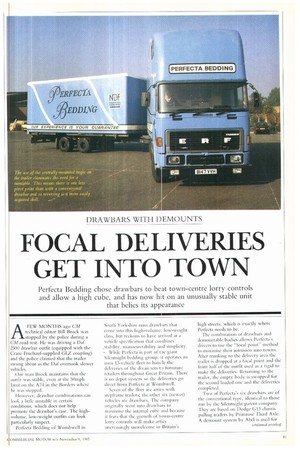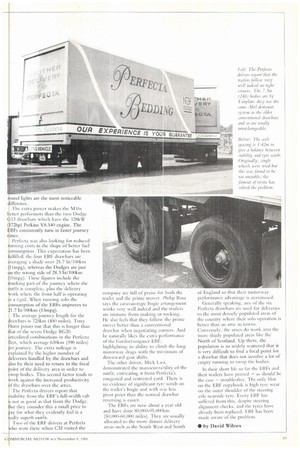FOCAL DELIVERIES GET INTO TOWN
Page 83

Page 84

Page 85

If you've noticed an error in this article please click here to report it so we can fix it.
Perfecta Bedding chose drawbars to beat town-centre lorry controls and allow a high cube, and has now hit on an unusually stable unit that belies its appearance
AFEW MONTHS ago CM technical editor Bill Brock was stopped by the police during a CM road test. He was driving a Daf 25(X) drawbar outfit (equipped with the Crane Fruehauf-supplied GLZ coupling) and the police claimed that the trailer swung about as the Dal overtook slower vehicles.
Our man Brock maintains that the outfit was stable, even at the 50mph limit On the A74 in the Borders where he was stopped.
llowever, drawbar comhinations can look a little unstable in certain conditions, which does not help promote the drawbar's case. The highvolume, low-weight outfits can look particularly suspect.
Perfecta Bedding of Wombwell in
South Yorkshire runs drawbars that come into this high-volume, low-weight class, but reckons to have arrived at a vehicle specification that combines istability, manoeuvrability and simplicity. While Perfecta is part of the giant Sdentnight bedding group, it operates its own 13-vehicle fleet to hancle the deliveries of the divan sets ra furniture retailers throughout Great Britain. There is no depot system so the deliveries go direct from Perfecta at Wombwell.
Seven of the fleet are artics with scepframe trailers; the other six (newer) vehicles are drawbars. The company origin.dly went into drawbars to moximise the internal cube Ind because it fears that the growth of town-centre lorry controls will make Junes 'increasingly unwelcome in Britain's
high streets, which is exactly where Perfecta needs to be.
The combination of drawbars and demountable bodies allows Perfecta's drivers to use the "focal pointmethod to minimise their intrusion into towns. After trunking to the delivery area the trailer is dropped at a focal point and the front half of the outfit used as a rigid to make the deliveries. Returning to the trailer, the empty body is swopped for the second loaded one and the deliveries completed.
Two of Perfecta's six drawbars are of the conventional type, identical to those run by the Silentnight parent company. They are based on Dodge G13 chassis pulling trailers by Primrose Third Axle. A demount system by Abel is used for the two 7.3m (241t) long bodies on each Outfit.
This combination works in as much as it provides a cavernous 102m3, compared with the 78m3 in the artic's stepframe trailers. But Perfecta suffers from a very restricted yard and wanted a drawbar outfit that would be more manoeuvrable without sacrificing any load space.
Perfecea latest four drawbars seem to provide the answer. They are based on ERE's 16-ton gross vehicle weight chassis, the M I6, in drawbar specification and pull trailers that feature a centrally mounted tandem axle. This arrangement can be likened to a heavyweight caravan's configuration, and its stability belies its unconventional appearance.
The company naturally wanted to retain complete interchangeability with the older Dodge drawbars and so the four new ERF outfits were engineered to accept the same 7.3in (241t)long box bodies (built by Vanplan) and use the same Abel demount system.
Each trailer is plated for 7,120kg, evenly distributed across its two axles. which have centres 1.42m apart. The four trailers were built by Primrose Third Axle just before it folded — Wheelbase Engineering rose in July 1984 from Primrose's ashes. Wheelbase's John Pickles, who was also at Primrose, says that the axle spacing was not determined by any critical calculation but is a compromise between being long enough to provide longitudinal stability and short enough to minimise tyre scrub.
Steel leaf suspension is used and twin 15-inch wheels are fitted.
Unlike a conventional drawbar trailer, no turntable and separate A-frame are needed. Instead, the chassis main rails extend forward and converge to form the A-frame. This means that the swing arc is effectively from the coupling all the way back to the trailer bogie.
With such a large swing arc the turning clearance gap between the two halves of the outfit can be reduced. The Perfecta vehicles run with a gap of 1.3m and come up to 18m overall length limit with the two 7.3m bodies.
This gap could he reduced further if even longer bodies were wanted. In this way, the centrally mounted bogie arrangement permits closer-than-usual coupling without incurring the $:3,000 or so expense of coupling systems that use extending A-frames.
"[he weight of the trailer's integral Aframe produces a very slight imbalance in the weight distribution; there is roughly 200kg of load imposed through
the coupling and so VBG load-bearing couplings are used. A jockey wheel is incorporated in the A-frame to provide additional stability when the trailer is standing uncoupled, and to adjust the coupling height if the trailer is on uneven ground.
Perfecta put these four new trailers on the road 12 months ago. At the same time, it introduced the ERE M16 into the fleet as prime movers for the drawbars. Perfecta's distribution manager Tony Hurst regards the EREs as a long-term proposition on the basis that lower running costs and a longer life will compensate for their substantially higher purchase price when compared with the existing Dodge G13 drawbars.
Whereas the Dodges are being kept for five years, the EREs are scheduled for a life of at least six or seven years with Perfecta. Their SMC (sheet moulded compound) patmelled cabs should survive the ravages of time better than steel ones, says Hurst.
Instead of the standard 111kW (150hp) Perkins engine in the M16, Perfecta chose the optional Gardner 6LXCT engine which has been available in this model since March last year.
This 167kW (224hp) engine is also used in the heavier ERE C-Series drawbar chassis and so it is bound to make the M16 a lively performer. Even fully laden with 170 of Perfecta's 3ft divan sets (or equivalent) the drawbars have a gross train weight of only 16 tonnes or so.
With their roof-mounted sleepers disguising the lower mounted cabs, these M16s are difficult to distinguish Irons the C-Series — their rectangular headlights in place of the C-Series twin pound lights are the most noticeable difference.
The extra power makes the M16s I:etter pet-limners than the two Dodge G13 drawbars which have the 128kW (172hp) Perkins V8.540 engine. The ERFs consistently turn in faster journey times.
Perfecta was also looking for reduced running costs in the shape of better fuel consumption. This expectation has been fulfilled; the four ERF drawbars are A veraging a shade over 25.7 lit/100km (11mpg), whereas the Dodges are just on the wrong side of 28.3 lit/100km (10mpg). these figures include the trunking part of the journey where the outfit is complete, plus the delivery work where the front half is operating
a rigid. When running solo the consumption of the ERFs improves to 21.7 lit/100km (13tripg).
The average journey length for the rawbars is 725km (45(1 miles). Tony Hurst points out that this is longer than that of the seven Dodge RG20
rticulated combinations in the Perfecta fleet, which average 630km (390 miles) er journey. The extra mileage is xplained by the higher number of deliveries handled by the drawbars and Is° by their need to return to the focal point of the delivery area in order to iwop bodies. This second factor tends to work against the increased productivity f the drawbars over the artics.
The Perfect' drivers report that isibility from the ERF's full-width cab is not as good as that from the Dodge.
But they consider this a small price to ay for what they evidently feel is a eally superb outfit.
Two of the ERF drivers at Perfecta who were there when CM visited the company are full of praise for both the trailer and the prime mover. Philip Rose says the caravan-type bogie :irrangement works very well indeed and the trailers are immune from snaking or rocking. He also feels that they follow the prime mover better than a conventional drawbar when negotiating corners. And he naturally likes the extra performance of the Gardner-enginer ERE% highlighting its ability to climb the long motorway drags with the ma Minim of downward gear shifts.
The other driver, Mick 1.as t, demonstrated the manoeuvrability of the outfit, extricating it from Perfecta's congested and restricted yard. There is no evidence of significant tyr: scrub on the trailer's bogie and with trie less pivot point than the normal drawbar reversing is easier.
The ERFs are now about a year old and have done 8031(10-95,000km (50,000-60,000 miles). They are usually allocated to the more distant delivery areas such as the South West and South
of England so that their motorway performance advantage is maximised.
Generally speaking, any of the six Perfecta drawbars are used for deliveries to the most densely populated areas of the country where their solo operation is better than an artic in towns. Conversely, the artics do work into the more thinly populated areas like the North of Scotland. Up there, the population is so widely scattered that it is very difficult to find a focal point for a drawbar that does not involve a lot of empty running to swop the bodies.
In their short life so far the ERFs and their trailers have proved — as should be the case — trouble-free. The only blot on the ERF copybook is high tyre wear on the outer shoulder of the steering axle nearside tyre. Every ERF has suffered from this, despite steering alignment checks, and the tyres have already been replaced. FRF has been made aware of the problem.
• by David Wilcox












































































































































